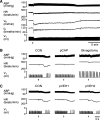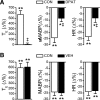8-OH-DPAT abolishes the pulmonary C-fiber-mediated apneic response to fentanyl largely via acting on 5HT1A receptors in the nucleus tractus solitarius
- PMID: 22696579
- PMCID: PMC3423994
- DOI: 10.1152/ajpregu.00016.2012
8-OH-DPAT abolishes the pulmonary C-fiber-mediated apneic response to fentanyl largely via acting on 5HT1A receptors in the nucleus tractus solitarius
Abstract
Intravenous bolus injection of morphine causes a vagal-mediated brief apnea (∼3 s), while continuous injection, via action upon central μ-opioid receptor (MOR), arrests ventilation (>20 s) that is eliminated by stimulating central 5-hydroxytryptamine 1A receptors (5HT(1A)Rs). Bronchopulmonary C-fibers (PCFs) are essential for triggering a brief apnea, and their afferents terminate at the caudomedial region of the nucleus tractus solitarius (mNTS) that densely expresses 5HT(1A)Rs. Thus we asked whether the vagal-mediated apneic response to MOR agonists was PCF dependent, and if so, whether this apnea was abolished by systemic administration of 8-hydroxy-2-(di-n-propylamino)tetral (8-OH-DPAT) largely through action upon mNTS 5HT(1A)Rs. Right atrial bolus injection of fentanyl (5.0 μg/kg, a MOR agonist) was performed in the anesthetized and spontaneously breathing rats before and after: 1) selective blockade of PCFs' conduction and subsequent bivagotomy; 2) intravenous administration of 5HT(1A)R agonist 8-OH-DPAT; 3) intra-mNTS injection of 8-OH-DPAT; and 4) intra-mNTS injection of 5HT(1A)R antagonist WAY-100635 followed by 8-OH-DPAT (iv). We found the following: First, fentanyl evoked an immediate apnea (2.5 ± 0.4 s, ∼6-fold longer than the baseline expiratory duration, T(E)), which was abolished by either blocking PCFs' conduction or bivagotomy. Second, this apnea was prevented by systemic 8-OH-DPAT challenge. Third, intra-mNTS injection of 8-OH-DPAT greatly attenuated the apnea by 64%. Finally, intra-mNTS microinjection of WAY-100635 significantly attenuated (58%) the apneic blockade by 8-OH-DPAT (iv). We conclude that the vagal-mediated apneic response to MOR activation depends on PCFs, which is fully antagonized by systemic 8-OH-DPAT challenge largely via acting on mNTS 5HT(1A)Rs.
Figures








Similar articles
-
Contribution of central μ-receptors to switching pulmonary C-fibers-mediated rapid shallow breathing into an apnea by fentanyl in anesthetized rats.Brain Res. 2012 Aug 21;1469:73-81. doi: 10.1016/j.brainres.2012.06.028. Epub 2012 Jun 30. Brain Res. 2012. PMID: 22759907 Free PMC article.
-
The counteraction of opioid-induced ventilatory depression by the serotonin 1A-agonist 8-OH-DPAT does not antagonize antinociception in rats in situ and in vivo.Anesth Analg. 2009 Apr;108(4):1169-76. doi: 10.1213/ane.0b013e318198f828. Anesth Analg. 2009. PMID: 19299781
-
Intravenous bolus injection of fentanyl triggers an immediate central and upper airway obstructive apnea via activating vagal sensory afferents.J Appl Physiol (1985). 2024 Dec 1;137(6):1666-1677. doi: 10.1152/japplphysiol.00614.2024. Epub 2024 Oct 17. J Appl Physiol (1985). 2024. PMID: 39417800
-
Peripheral 5-HT1A receptors are not essential for increased ventilation evoked by systemic 8-OH-DPAT challenge in anaesthetized rats.Exp Physiol. 2007 Sep;92(5):953-61. doi: 10.1113/expphysiol.2007.037333. Epub 2007 May 25. Exp Physiol. 2007. PMID: 17526557
-
Peripheral neuroplasticity of respiratory chemoreflexes, induced by prenatal nicotinic exposure: Implication for SIDS.Respir Physiol Neurobiol. 2023 Jul;313:104053. doi: 10.1016/j.resp.2023.104053. Epub 2023 Apr 4. Respir Physiol Neurobiol. 2023. PMID: 37019251 Review.
Cited by
-
L-cysteine methyl ester overcomes the deleterious effects of morphine on ventilatory parameters and arterial blood-gas chemistry in unanesthetized rats.Front Pharmacol. 2022 Sep 28;13:968378. doi: 10.3389/fphar.2022.968378. eCollection 2022. Front Pharmacol. 2022. PMID: 36249760 Free PMC article.
-
Tropine exacerbates the ventilatory depressant actions of fentanyl in freely-moving rats.Front Pharmacol. 2024 Jun 24;15:1405461. doi: 10.3389/fphar.2024.1405461. eCollection 2024. Front Pharmacol. 2024. PMID: 38978984 Free PMC article.
-
S-Nitroso-L-Cysteine Stereoselectively Blunts the Deleterious Effects of Fentanyl on Breathing While Augmenting Antinociception in Freely-Moving Rats.Front Pharmacol. 2022 May 26;13:892307. doi: 10.3389/fphar.2022.892307. eCollection 2022. Front Pharmacol. 2022. PMID: 35721204 Free PMC article.
-
Depressed GABA and glutamate synaptic signaling by 5-HT1A receptors in the nucleus tractus solitarii and their role in cardiorespiratory function.J Neurophysiol. 2014 Jun 15;111(12):2493-504. doi: 10.1152/jn.00764.2013. Epub 2014 Mar 26. J Neurophysiol. 2014. PMID: 24671532 Free PMC article.
-
Neuronal mechanisms underlying opioid-induced respiratory depression: our current understanding.J Neurophysiol. 2021 May 1;125(5):1899-1919. doi: 10.1152/jn.00017.2021. Epub 2021 Apr 7. J Neurophysiol. 2021. PMID: 33826874 Free PMC article. Review.
References
-
- Aicher SA, Goldberg A, Sharma S, Pickel VM. mu-opioid receptors are present in vagal afferents and their dendritic targets in the medial nucleus tractus solitarius. J Comp Neurol 422: 181– 190, 2000 - PubMed
-
- Belvisi MG, Hele DJ. Cough Sensors. III. Opioid and cannabinoid receptors on vagal sensory nerves. In: Handbook of Experimental Pharmacology, Berlin, Germany: Springer-Verlag, 2009, vol. 187, p. 63– 76 - PubMed
-
- Bianchi AL, Denavit-Saubie M, Champagnat J. Central control of breathing in mammals: neuronal circuitry, membrane properties, and neurotransmitters. Physiol Rev 75: 1– 45, 1995 - PubMed
Publication types
MeSH terms
Substances
Grants and funding
LinkOut - more resources
Full Text Sources
Research Materials

